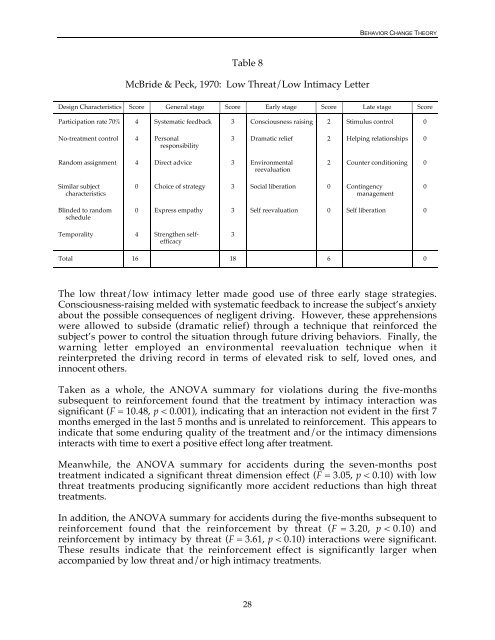Application of Behavior Change Theory to the Development
Application of Behavior Change Theory to the Development
Application of Behavior Change Theory to the Development
Create successful ePaper yourself
Turn your PDF publications into a flip-book with our unique Google optimized e-Paper software.
Table 8<br />
McBride & Peck, 1970: Low Threat/Low Intimacy Letter<br />
28<br />
BEHAVIOR CHANGE THEORY<br />
Design Characteristics Score General stage Score Early stage Score Late stage Score<br />
Participation rate 70% 4 Systematic feedback 3 Consciousness raising 2 Stimulus control 0<br />
No-treatment control 4 Personal<br />
responsibility<br />
Random assignment 4 Direct advice 3 Environmental<br />
reevaluation<br />
Similar subject<br />
characteristics<br />
Blinded <strong>to</strong> random<br />
schedule<br />
Temporality 4 Streng<strong>the</strong>n selfefficacy<br />
3 Dramatic relief 2 Helping relationships 0<br />
2 Counter conditioning 0<br />
0 Choice <strong>of</strong> strategy 3 Social liberation 0 Contingency<br />
management<br />
0 Express empathy 3 Self reevaluation 0 Self liberation 0<br />
3<br />
Total 16 18 6 0<br />
The low threat/low intimacy letter made good use <strong>of</strong> three early stage strategies.<br />
Consciousness-raising melded with systematic feedback <strong>to</strong> increase <strong>the</strong> subject’s anxiety<br />
about <strong>the</strong> possible consequences <strong>of</strong> negligent driving. However, <strong>the</strong>se apprehensions<br />
were allowed <strong>to</strong> subside (dramatic relief) through a technique that reinforced <strong>the</strong><br />
subject’s power <strong>to</strong> control <strong>the</strong> situation through future driving behaviors. Finally, <strong>the</strong><br />
warning letter employed an environmental reevaluation technique when it<br />
reinterpreted <strong>the</strong> driving record in terms <strong>of</strong> elevated risk <strong>to</strong> self, loved ones, and<br />
innocent o<strong>the</strong>rs.<br />
Taken as a whole, <strong>the</strong> ANOVA summary for violations during <strong>the</strong> five-months<br />
subsequent <strong>to</strong> reinforcement found that <strong>the</strong> treatment by intimacy interaction was<br />
significant (F = 10.48, p < 0.001), indicating that an interaction not evident in <strong>the</strong> first 7<br />
months emerged in <strong>the</strong> last 5 months and is unrelated <strong>to</strong> reinforcement. This appears <strong>to</strong><br />
indicate that some enduring quality <strong>of</strong> <strong>the</strong> treatment and/or <strong>the</strong> intimacy dimensions<br />
interacts with time <strong>to</strong> exert a positive effect long after treatment.<br />
Meanwhile, <strong>the</strong> ANOVA summary for accidents during <strong>the</strong> seven-months post<br />
treatment indicated a significant threat dimension effect (F = 3.05, p < 0.10) with low<br />
threat treatments producing significantly more accident reductions than high threat<br />
treatments.<br />
In addition, <strong>the</strong> ANOVA summary for accidents during <strong>the</strong> five-months subsequent <strong>to</strong><br />
reinforcement found that <strong>the</strong> reinforcement by threat (F = 3.20, p < 0.10) and<br />
reinforcement by intimacy by threat (F = 3.61, p < 0.10) interactions were significant.<br />
These results indicate that <strong>the</strong> reinforcement effect is significantly larger when<br />
accompanied by low threat and/or high intimacy treatments.<br />
0
















